Quick Bites:
- The blog discusses cloning virtual machines (VMs) in Hyper-V and the best practices for this process.
- Hyper-V Manager lacks a native cloning option; instead, VMs can be exported and then imported to achieve cloning.
- Windows Admin Center offers a more straightforward cloning process with a native clone option.
- Sysprep is recommended for ensuring cloned VMs function properly in a network by generating a unique security identifier.
- The blog provides detailed steps for both exporting/importing in Hyper-V Manager and cloning in Windows Admin Center.
When working with virtual machines in Hyper-V, there are many operations with which you will want to familiarize yourself. In addition, virtual machines afford many options for working with your production-critical workloads. In addition to creating virtual machine snapshots, like physical workstations and servers, you can clone your Hyper-V virtual machines to create identical copies of a VM or provide a starting point for a new machine. Let’s consider Hyper-V clone VM for beginners and see how you can clone your Hyper-V virtual machines when needed.
Table of Contents
- Hyper-V VM clones – what are they and best practices
- Hyper-V Manager is limited regarding clones
- Windows Admin Center Clone process
- Hyper-V Clone VM FAQs
- What is a VM clone?
- Can you clone a Hyper-V virtual machine using Hyper-V Manager?
- Why is Windows Admin Center a better tool for Hyper-V cloning?
- Wrapping up
Hyper-V VM clones – what are they and best practices
When you clone a virtual machine, you essentially take an identical copy of the source virtual machine to take a “cookie cutter” approach to create a new virtual machine identical to the source. You can also customize a VM clone, so it is not viewed as an exact copy, with the same security identifiers, etc. This approach is preferred in a Windows domain environment.
On a Windows client or Windows Server, you can run an operation called “Sysprep” that generalizes the operating system in a way that makes it unique on the network and in a Windows domain. In addition, it generates a new security identifier so the machine can function properly and not result in conflicts on the network. While there are mixed opinions on whether this is needed with modern Windows operating systems, it is still generally considered the best practice when cloning a physical or virtual machine.
One thing to remember when you clone a virtual machine is whether or not you “Sysprep” the virtual machine, Hyper-V will generate a new MAC address for the virtual machine. It is so it can communicate on the network, as you cannot have two virtual machines with the same MAC address. This point is crucial to note if you have licensing or other applications tied to a specific MAC address and should be kept in mind.
Hyper-V Manager is limited regarding clones
When it comes to the Hyper-V manager, it is limited in its ability to create clones. When you go into the Hyper-V Manager, you will notice there is no option to clone a virtual machine, and when you right-click on a VM in Hyper-V Manager, you will see the below options only. These include checkpoint, move, export, rename, delete, enable replication, etc.
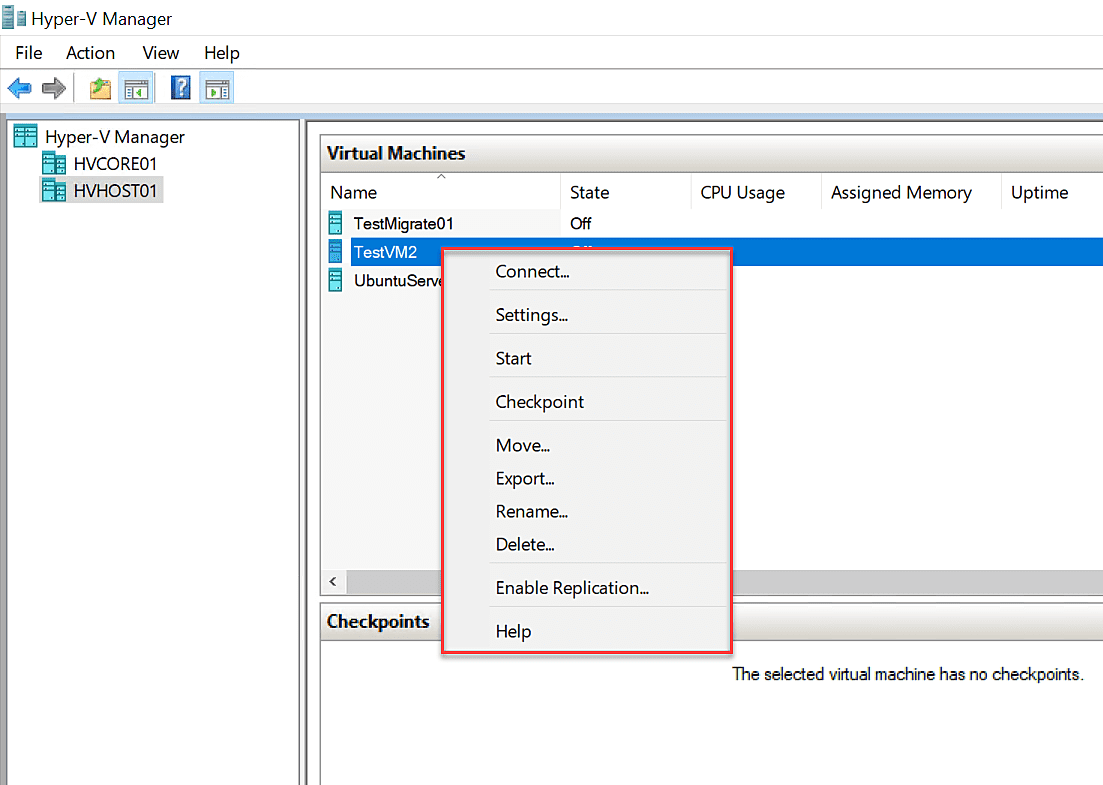
Is there no way to clone a Hyper-V virtual machine effectively in Hyper-V Manager? Even though there is no explicit way to clone a virtual machine from the context manager, we can perform a VM export as a template. If you choose to Export a virtual machine, you will be asked to select a location for the export. Browse to a folder and then click Export.

After the Hyper-V virtual machine is exported to the export location, you can then import the virtual machine back into the Hyper-V environment. Right-click your Hyper-V host and choose to Import Virtual Machine.
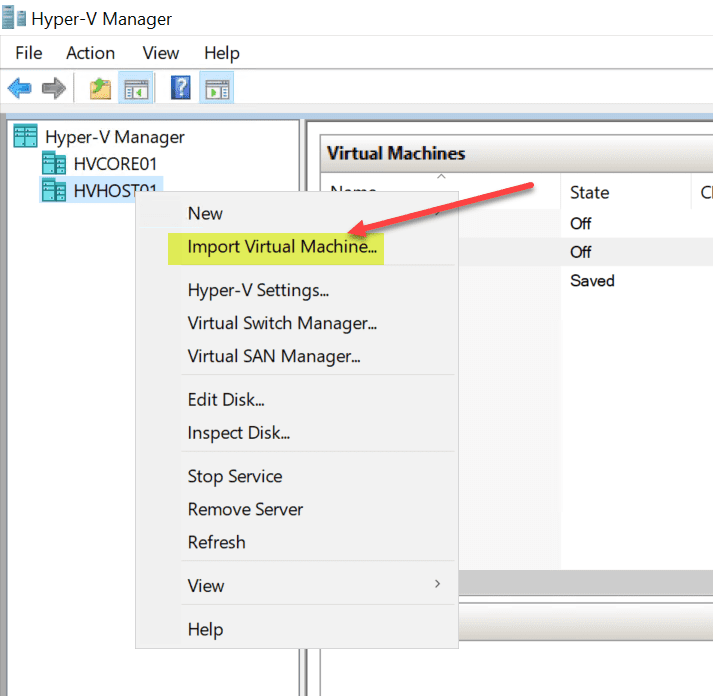
On the Import Virtual Machine wizard, on the Choose Import Type screen, you can choose the option: Copy the virtual machine (create a new unique ID). This option will create a copy of the virtual machine you exported, essentially a clone.
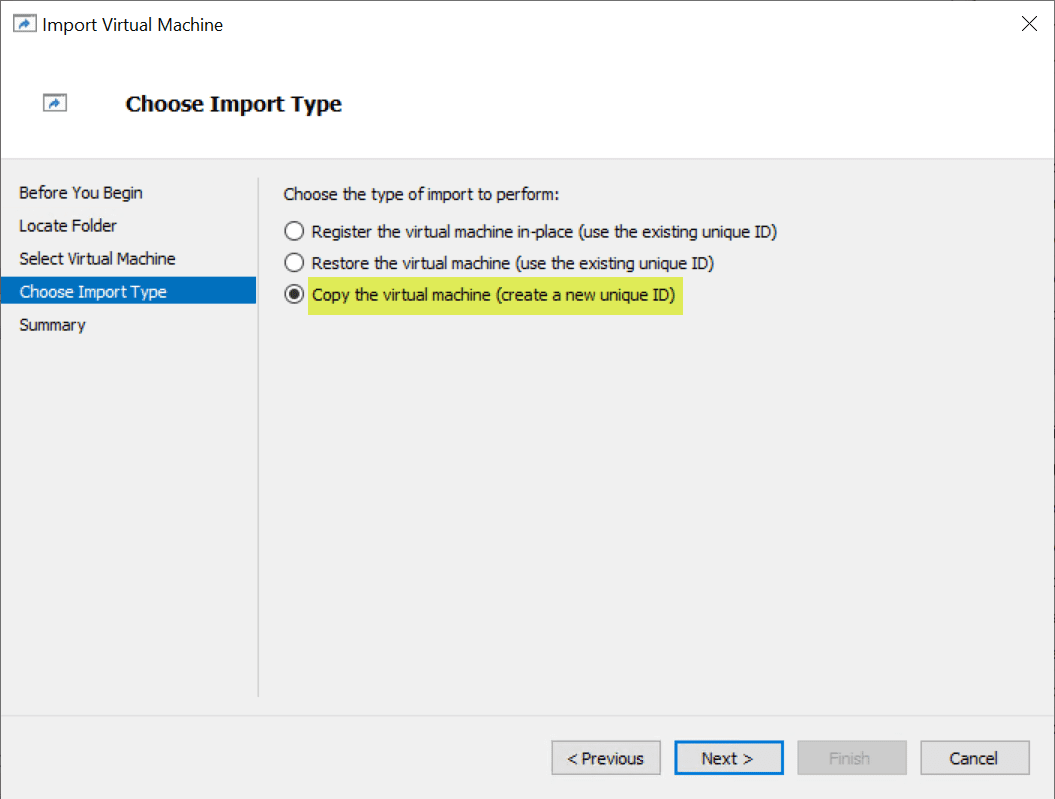
Windows Admin Center Clone process
Windows Admin Center is the preferred tool moving forward for managing modern Windows and virtualization environments. It provides modern tools that allow admins to easily access, manage, configure, and administer their environments.
While Windows Admin Center is still lagging in some respects, comparing feature parity with Hyper-V Manager yet, Microsoft is feverishly adding new features to Windows Admin Center. However, one feature available in Windows Admin Center is the ability to clone a Hyper-V virtual machine natively.
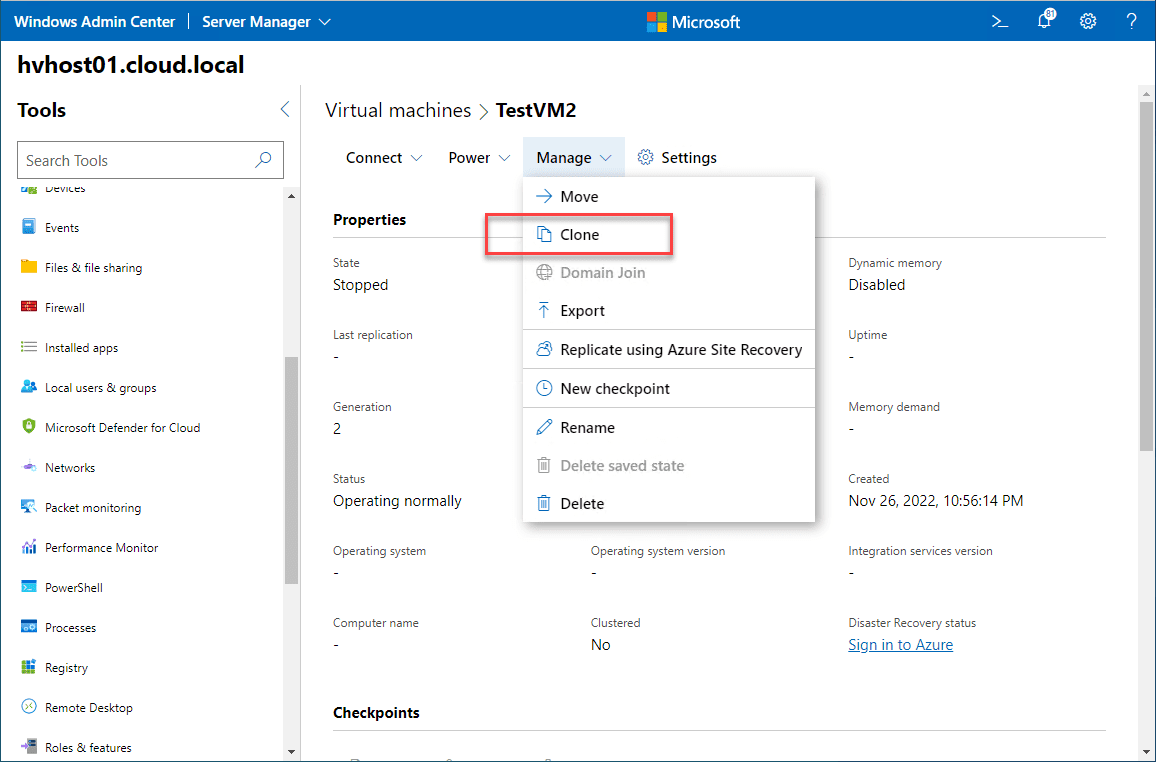
Once the clone process is launched, the Clone a virtual machine blade pops up. Here, we name the clone, set a path for the virtual machine on disk, and make the selection on the Sysprep option.
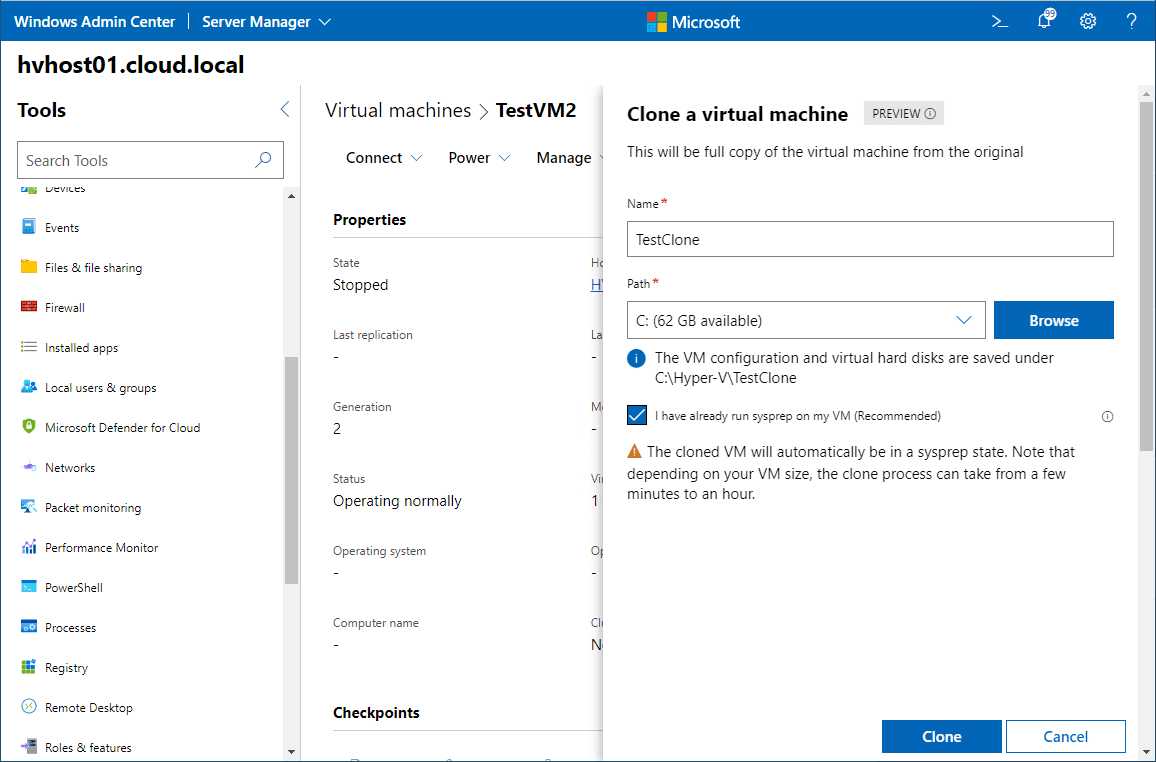
After the clone operation finishes successfully, you will see the new cloned virtual machine in your virtual machine inventory in Windows Admin Center.
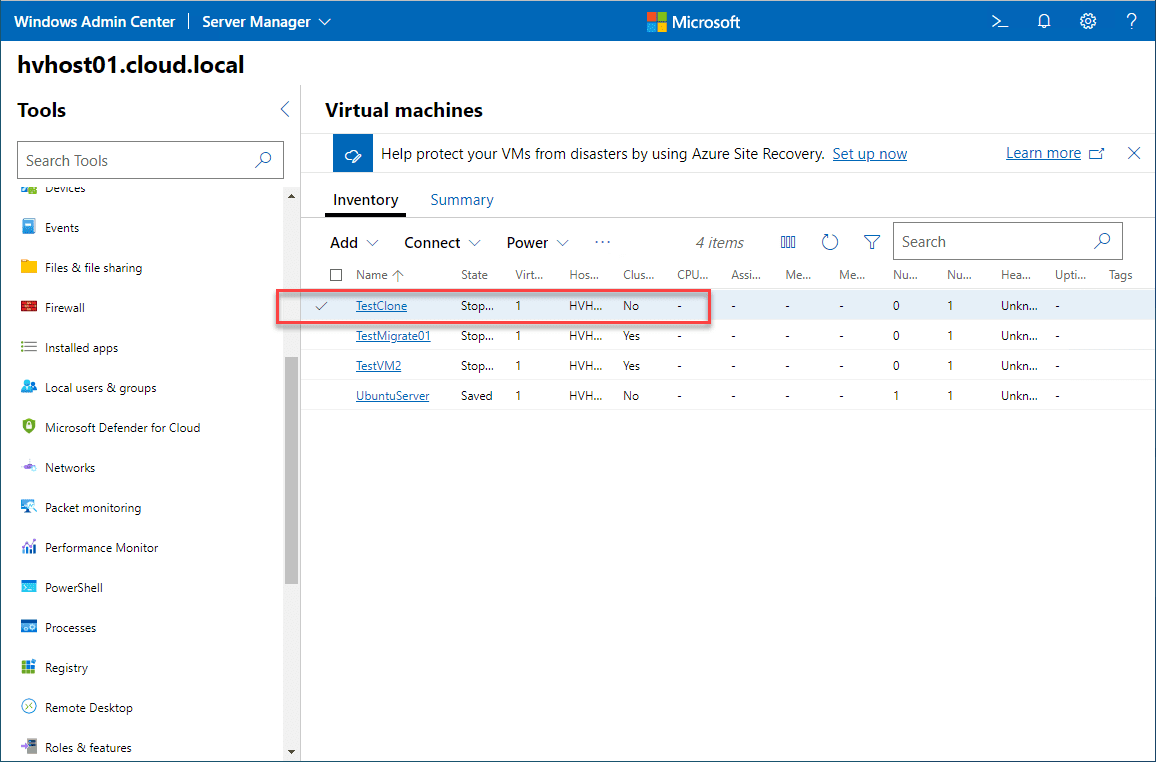
Hyper-V Clone VM FAQs
What is a VM clone?
A virtual machine clone is taking an exact copy of a specific virtual machine and duplicating that virtual machine to create a brand new virtual machine with identical hardware, applications, software, configuration, etc. However, with Windows, the Sysprep operation helps to ensure the cloned virtual machine can coexist with the clone source on the network. In addition, it generalizes the configuration to allow the Windows machine to function correctly in a Microsoft domain environment.
Can you clone a Hyper-V virtual machine using Hyper-V Manager?
You can create the same result as a clone operation with Hyper-V Manager. However, there is no specific option to perform a clone operation. Instead, with Hyper-V Manager, you must perform an export and then import the virtual machine. This operation creates an exact copy that can be re-imported to the environment as a different virtual machine.
Why is Windows Admin Center a better tool for Hyper-V cloning?
Windows Admin Center speeds up the process for the clone operation with Hyper-V since it has a native option for “clone” in the menu options.
Wrapping up
Hyper-V provides many great tools for interacting with and managing virtual machines. Hyper-V Manager has long been the preferred tool for managing Hyper-V virtual machines. However, Hyper-V Manager has no native way to clone virtual machines. The new Windows Admin Center (WAC) provides excellent tools for working with Hyper-V virtual machines. One of those is the ability to clone a virtual machine using Windows Admin Center. Cloning a VM in Windows Admin Center is as easy as kicking off the clone operation from the web interface in Windows Admin Center.
Read More on our Hyper-V series:
Hyper-V Mastery: A Step-by-Step Guide for Beginners to Elevate Your IT Skills and Boost Your Career
How to export and import VMs from Hyper-V
Beginners’ Guide for Microsoft Hyper-V: How to Export and Import Hyper-V VM’s – Part 26
Beginners’ Guide for Microsoft Hyper-V: How to Import OVA into Hyper-V – Part 44
Beginners’ Guide for Microsoft Hyper-V: Hyper-V Nested Virtualization in Microsoft Azure – Part 51
Hyper-V Mastery: A Step-by-Step Guide for Beginners to Elevate Your IT Skills and Boost Your Career
Follow our Twitter and Facebook feeds for new releases, updates, insightful posts and more.



Leave A Comment